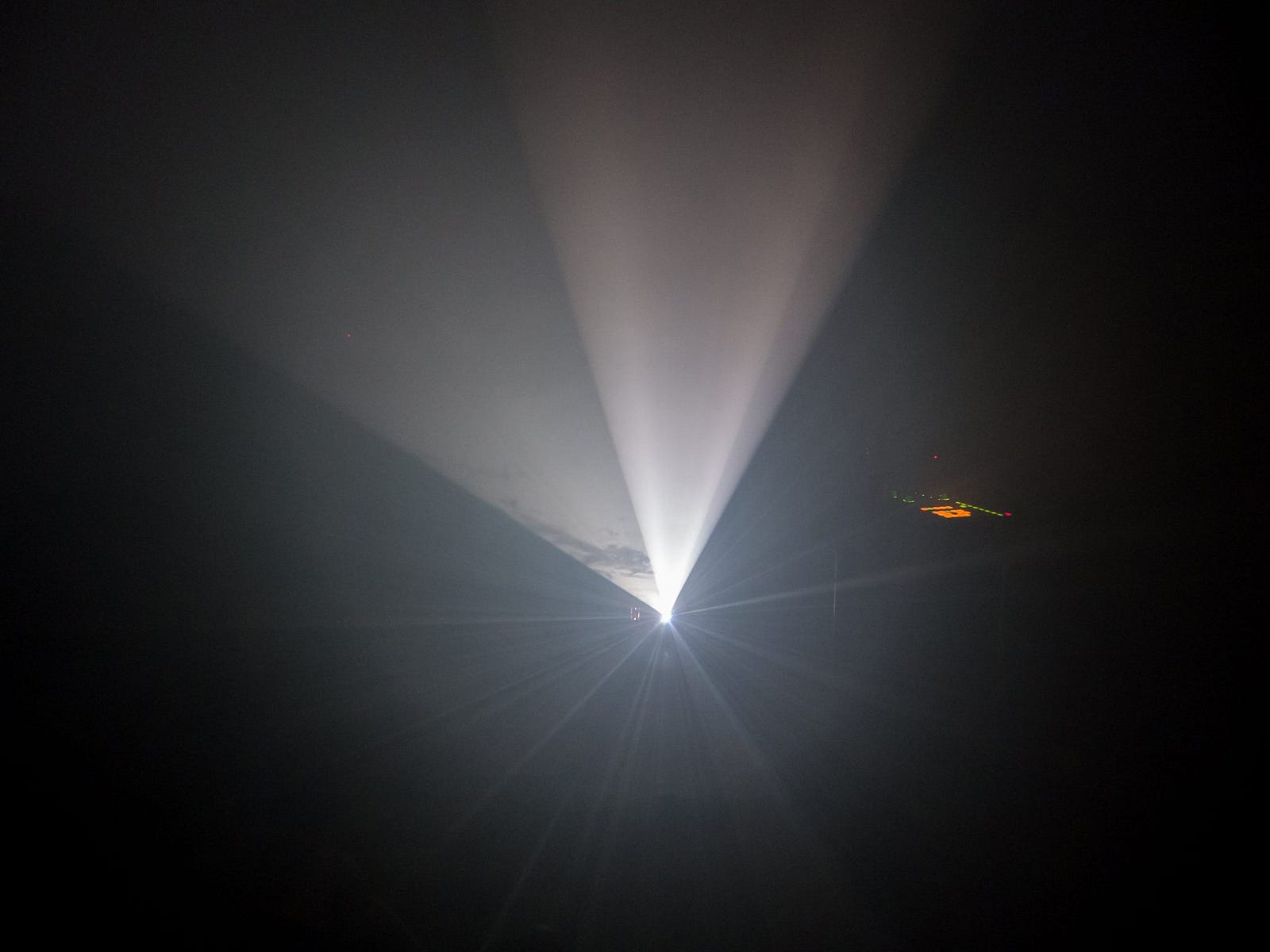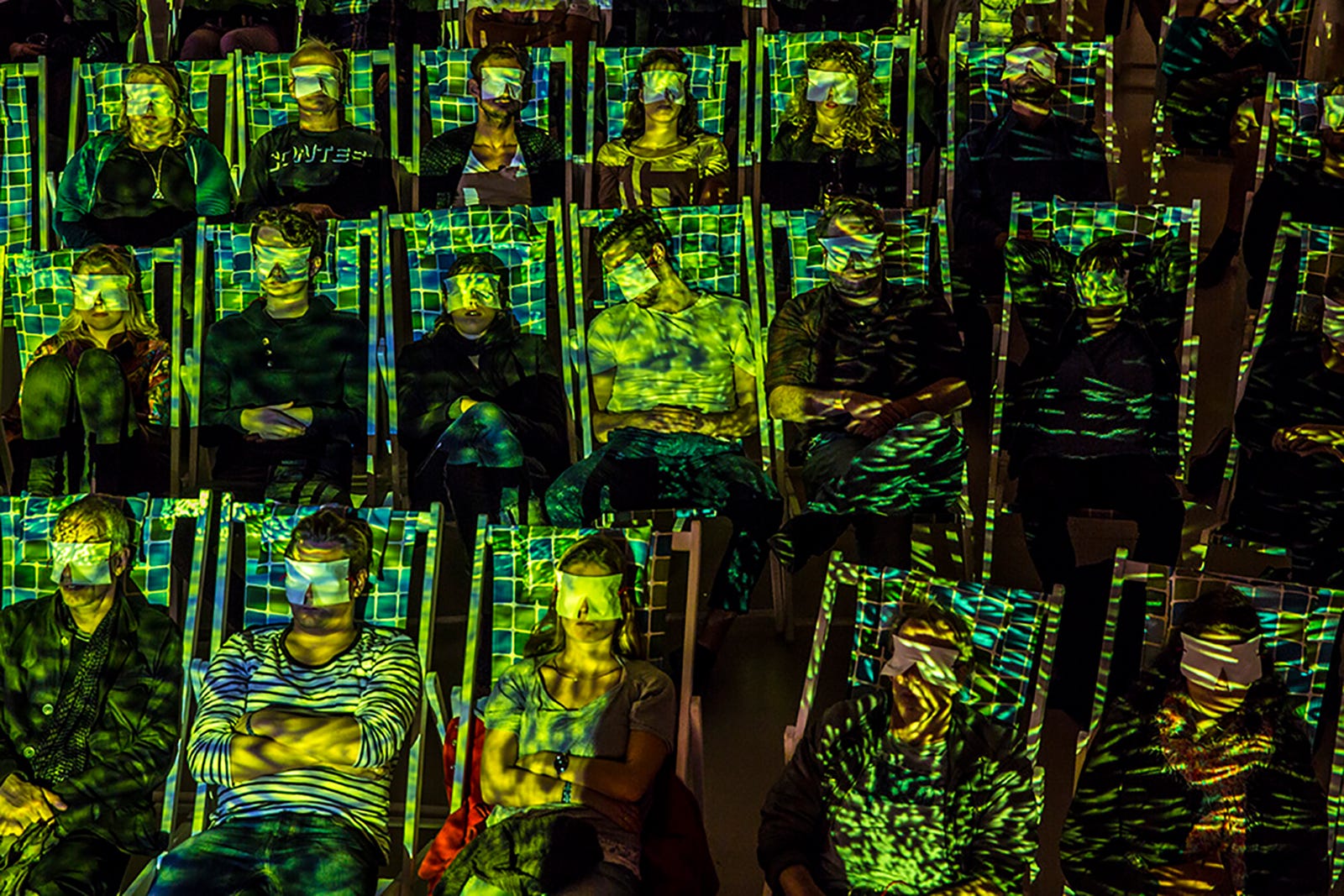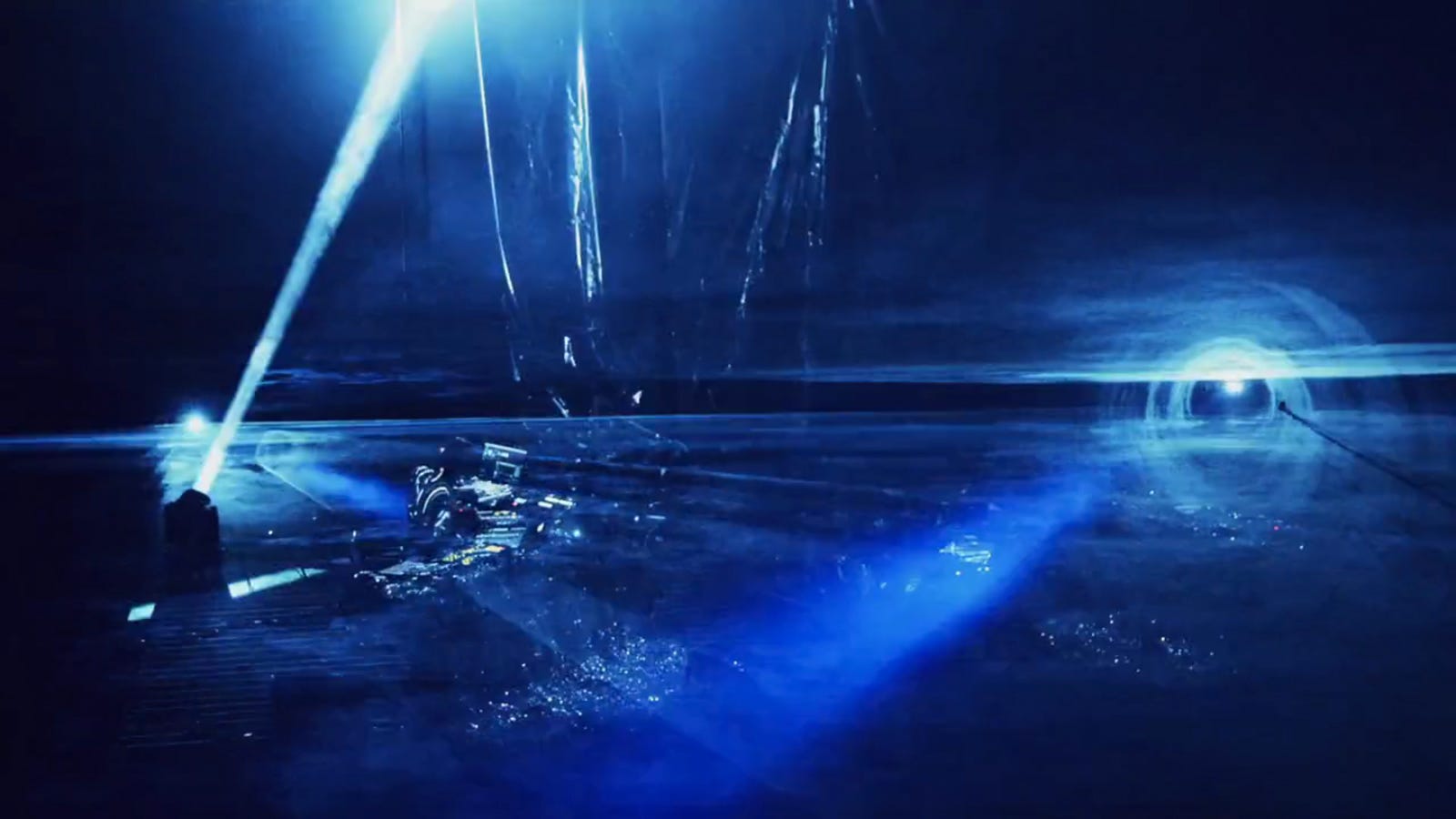
.
Doron Sadja is a Berlin-based sound artist who experiments with digital sound, light and space. He often uses multi-channel spatialized sound, intense lights and smoke machines for his audio-visual performances and installations.
The art he creates seems very specific and scientific-research focused. Doron Sadja combines noise, electronic sounds with warm and mainstream sounding synthesizers, and adds spatial, programmatically controlled lights and projections that are itinerating throughout vapory environments.
Sadja is originally from Los Angeles and lived in New York for ten years. He studied Technology in Music and Related Arts at the Oberlin Conservatory of Music and received his MFA in Sound Art from Bard College. He has been based in Berlin for only two years and already has been showcased in such well known electronic music and digital art festivals as Transmediale/CTM, Atonal, Retune, 3HD, Norberg.
Irina: Doron, could you please define what sound, light, and space means to you?
Doron Sadja: Thats a hard one! I put “sound, light, and space” in my bio, but I think my life’s work will actually be trying to figure out what those things actually mean. Essentially, they’re all vibrations. Sound and light both vibrate at different frequencies which determine their sonic qualities, pitch, color, intensity, etc., but they also vibrate on an emotional, intellectual, and perceptual level. While a space doesn’t necessarily physically vibrate, it emits an energy or a feeling, which is perhaps similar to a vibration. The specificities of its architecture, it’s acoustics, its history, it’s current use, the way people engage with it, etc. — all combine to create radically different experiences of space, and this space in turn creates a dialogue with sound and light vibrations. A symbiotic relationship that charges the performance or installation.
Irina Spicaka: Do you always create your art work by starting with the composition of sound or sometimes is it the opposite — a visual idea comes first and you build your performance or installation on top of that vision?
Doron Sadja: There’s not really a standard starting place with how I begin a new work. In general, my working process involves a lot of experimentation and play: improvising with sounds, programming Reaktor patches, turning on a smoke machine and experimenting with lights, refracting projections through different materials, etc. There’s an immense value to just working with materials and getting to know them, and this play of materials can lead to all sorts of discoveries and larger works. A visual idea is just as likely to spark the inspiration for a piece as is a sonic idea, but even though the initial inspiration might be more visual or auditory, the outcome of the piece may end up dealing with the opposite sense. Besides sound or visuals being the starting point for a new work, there’s also a third place that my works often begin with which has more to do with site specificity.
I’m inspired by architecture, acoustics, and the ways in which people engage with a space. Whenever possible, I like to spend a long time scoping out a venue or gallery before working on a project so that I can try to create something completely new that reacts to that environment or perhaps modify an existing work to fit that location. Often, the outcome of a work will be a constant feedback and collaging of visual, sonic, and spatial ideas. We’ll be talking a lot about site specificity and creating systems for approaching site specificity in the upcoming CC4AV workshops because it’s something I’m very interested in and passionate about.

Irina Spicaka: Why, in your opinion, spatialization of sound is so important in Contemporary Music and Art?
Doron Sadja: Well, I wouldn’t to argue that spatialization is an essential part of contemporary music and art because it’s not something that everyone necessarily needs to engage with. There are lots of artists who don’t think about it at all but make wonderful contemporary work. What I would say is that it’s an incredibly valuable tool at our disposal, and it seems silly for artists to ignore it. The lushness and complexity of the sonic possibilities are unparalleled. And by setting up unique multi-channel speaker arrays, you can really perform work that interacts with a space. I like to think of architecture as a really really expensive filter which overlays its personality onto your sound. While there are no knobs on this filter, it’s far from static: the location of each speaker can radically change the quality of the sound, and by moving sound through multiple speakers you can activate different qualities of the building’s personality for use as a compositional tool.
Additionally, a big argument for the creation of multichannel work comes from the way we currently engage with media. What percentage of the music we listen to is experienced through headphones or laptop speakers? What percentage of art do we experience through a 5 inch phone screen? Not to be negative about this — it opens up a whole new way of engaging with work — but what are the deficiencies of this kind of experience? How can a performance or an installation provide a completely different type of experience — one that cannot be reproduced on a computer screen or headphones? Before recorded media it was necessary to be at a concert in order to hear the music, but now we have the world of music at our fingertips, so what is the role of live performance now and how can we maximize and explore it’s potential? I think there’s a beauty in creating work that can only be experienced in the moment and at that particular location, and working with spatial elements really helps achieve this.

Irina Spicaka: You create projections and use them as light that interacts with smoke, it is quite an unusual approach. I have seen Robert Henke working with lasers and smoke in his A/V live shows, that makes sense to me. It is really amazing to see how laser breaks through fume. You mentioned in one of your interviews that rectangular-screen projections seem boring to you. I assume, you are more about atmosphere and giving the audience space to interact with your art, is it correct?
Doron Sadja: First of all I’d like to clarify that I don’t think all screen projections are boring — I just feel that they’re problematic. There’s often an insecurity in the sound art world that sound alone is ‘not enough’ — that somehow there needs to be a visual element to make the sound performance ‘less boring’. I understand this. There’s a fear that watching a performer on stage with a laptop might not be as exciting as watching someone shred on guitar — and the truth is, it’s not. What this often results in is that artists who spend 95% of their time developing a unique sonic language end up throwing ill-planned projections which they barely developed onto a screen, distracting the audience from the fascinating sound that’s happening.
If we’re asking the world to approach sound as an art, and as something that can hold its own outside of traditional music or visual art, does it really help to think that it’s ‘not enough’ on its own? The second — and larger — issue I have with screen projections has more to do with my own passion for sound. Sound is 3-dimensional. It completely envelopes you — vibrating your body and eardrums from all directions — massaging you — responding to the architecture of the room and the bodies in it. It only takes one speaker to completely immerse a room in sound. A screen projection on the other hand, is a 3:2 or 16:9 rectangle that we stare at.
Since we’re such a visual culture, the flat box of the projection screen tends to become dominant and the sound becomes submissive, like soundtrack material meant to enhance a film. When done well it’s wonderful, but in general I feel that more often than not it flattens the sound which could have been much more interesting and multi-dimensional on its own. This is why I generally work with light as a medium instead of projection screens. I want to be completely immersed in both sound and light, and I want the audience to feel like they can explore the room and how sound and light change as you move through space. This creates a much more interesting audio-visual dynamic for me.
With all that said, I’m not totally against projection screens. I’ve incorporated projections in performances at times, and I have a collaboration with Nenad Popov here in Berlin that I think works really well because of the overwhelming complexity of his visuals. What I mean to say by complaining about projections, and what I hope to bring to people’s attention during the CC4AV workshops this November/December, is that there are alternative approaches to visuals during performances, and it’s a very exciting platform to explore.

Irina Spicaka: I have found out in an interview for iii’s No Patent Pending that sound artists Maryanne Amacher, Laurie Spiegel, Autechre and Aphex Twin inspired your earlier work. Autechre and Aphex Twin are obviously the artists who are well known in the experimental and techno music scenes and inspired our generation in the late 1990’s and early 2000’s. We can recognize sound patterns and rhythms, as well as sound producing methods in our own work. That continuity is amazing! Is there something else that inspires you to create such an immersive sound and light environments? Maybe nature, dreams or science fiction movies?
Doron Sadja: Sure, I find inspiration in all aspects of life! Photos of the cosmos; extreme weather patterns; architecture renderings. The fiery combination of clouds, lightning, and lava that occurs during a volcanic eruption is one of the most beautiful things in the world. I grew up in Santa Monica, a small seaside city in Los Angeles which can get incredibly foggy at night. One of my favorite things to do when I go home is to go to the end of the Santa Monica Pier where families are fishing and stare off into the abyss of the Pacific Ocean. If you’re lucky, on really foggy nights it feels like you’re standing on the edge of the world — like there’s nothing beyond the end of the pier except for the occasional flash of light from a buoy or boat. Maybe my obsession with smoke comes from these misty nights~

Irina Spicaka: May I say that you like pop music as much as noise and experimental music, and that you value quality and open mindedness when it comes to producing sound and merging different genres together? How does the music of the future sound in your head?
Doron Sadja: I think it’s incredibly important to be open minded to everything from pop music to noise to country to whatever. I don’t think there are any truths — or rights & wrongs — in music: it’s a method of communication and there are an infinite number of experiences and emotions that need to be communicated. As to the future of sound, I think that in a certain sense we’ve pushed traditional music to it’s logical extreme, and the way forward probably has a lot more to do with expanding the definition of sound to include all the senses. “We usually think of the camera as an eye and the microphone as an ear, but all the senses exist simultaneously in our bodies” (Bill Viola).

Irina Spicaka: Can you describe the difference between the experimental art scenes of LA and NYC in comparison to Berlin? Is there something in particular that made you to move to Berlin?
Doron Sadja: It’s a bit hard for me to compare Berlin scene to the LA scene since I haven’t properly lived there in a really long time, but I was deeply involved in the NYC scene before coming out here. I think one of the most different aspects of the experimental art scene in Berlin compared to NYC is that people in Berlin have time. Time to experiment, time to try new things, time to simmer on ideas. I really appreciate this approach and think that it leads to a lot of openness. On the other hand, NYC’s intensity and the necessity to have a full time day job besides working on one’s art can also lead to interesting things happening. In a sense, maybe there’s less bullshit in NYC because it’s so cut-throat. But, theres bullshit everywhere…. Another general difference between Europe and the US is that Europe is a lot more interested in technology. I at once find this really exciting but also can find it frustrating when it seems like the interest in the technology can be more important than the work.
Irina Spicaka: CC4AV will be hosting two of your workshops in November and December in Berlin. This will be the first time you will teach your techniques, right? What does knowledge sharing mean to you?
Doron Sadja: Indeed — the CC4AV workshop will be the first time I’ve had the opportunity to share my working techniques with others. I’ve been involved with collectives or art spaces where it felt that there was a constant sharing of ideas, like we were all each other’s teachers, but this is the first time doing anything like this. In a sense, when you’re a multi-media artist your tools are almost as important to the compositional process as the concept behind it — so it will be really interesting to share my methods with people and see what kind of new life they give it. The closest thing I’ve done to something like this is the Sound Portraits series here in Berlin, where I give a 2 hour lecture/listening session every month about a different ‘iconic’ electronic music composer. What I’ve found so interesting about doing these is that teaching ends up involving a lot of learning, so I assume this much more intense series of workshop will be just as much of an intense learning process for me too.
Irina Spicaka: You will be teaching to create multi-channel sound using Reactor visual programming software during your first workshop, and in the second workshop to create immersive sound and light environments using Reactor, Arena and DMX lightning. Can you please tell how artists, designers, technologists would benefit from the workshops and why it is useful to learn these tools?
Doron Sadja: Each of these tools we’ll be focusing on are incredibly useful, each in their own way as well as when used together. Reaktor is my baby — it’s at the heart of most of my projects and I’ve been using it since the early 2000s when it was still called Generator. It’s similar to Max/MSP but I think the interface is much slicker and user friendly. The benefits of a program like Reaktor is that it can transform any idea into an instrument. While it can do any normal effect or synthesizer sound, it’s possible to create completely custom instruments that change the way you interact with sound. Once you learn a program like Reaktor, you’re never the same again
Arena is perhaps one of the most user friendly VJ softwares I’ve ever used, while at the same time being incredibly powerful and professional.
It’s so useful that I really believe it’s one of those tools that everyone should learn to use. Besides complex projections with multiple outputs and simple projection mapping, I’ve even used it for slideshows — it does everything. As far as DMX lighting goes, I think it’s just an incredibly useful tool to have at your fingertips. Most clubs will have DMX lighting rigs already built into their venues, which with a little bit of setup time at the venue, can be yours to control and synchronize to your performance. It’s also gotten so cheap to buy your own LED lights, there’s almost no excuse not to learn how to incorporate them into your work!
Irina Spicaka: If you ever decide to learn something new, which direction you would go? Which technology seems interesting and challenging to you?
Doron Sadja: I really don’t know. I feel like i still have so much to learn from the tools I use, but I’m definitely interested in working with VR in the future as well as learning more about motion tracking to create more reactive works.
___________________________________________________________________
Notes:
Deepen your knowledge about Reaktor, Arena and DMX lightning with Doron Sadja during his 5-day long workshops.
Workshop ➝ Approaches to Multichannel Sound Using Reaktor
November 22nd — 26th, Berlin, Germany
Workshop ➝ Spatial sound and lights using Reaktor, Arena, DMX
November 29th — December 3rd, Berlin, Germany
Apply ➝ http://www.cc4av.info/2016/berlin-reactor/
Original article on DigiCult:
http://www.digicult.it/it/news/doron-sadja-creating-immersive-sound-light-environments/
